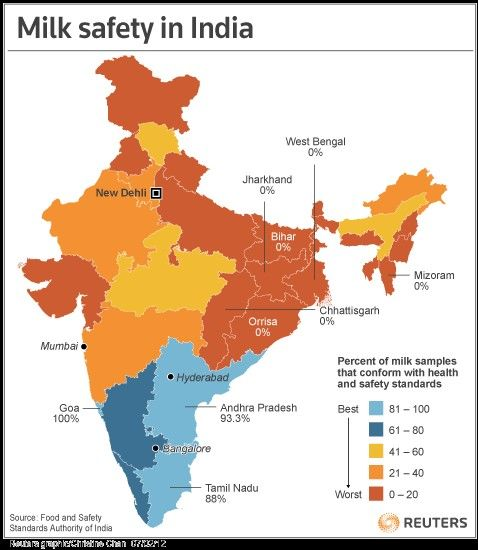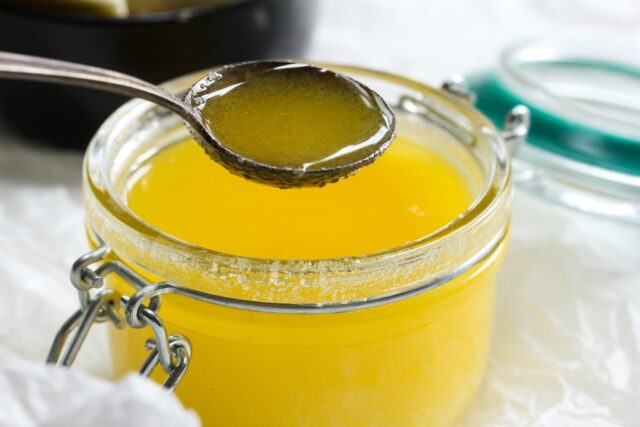Introduction:–
India, being the largest and top milk producing country in the world produced around 209.96 MT in 2020-21 with a CAGR of 6.2. Highly consumed and traded Indian milk product next to liquid milk is Ghee. About 28% of the total milk produced used for ghee production. According to FSSR-2011, ghee means the pure heat clarified fat derived solely from milk or curd or from desi (cooking) butter or from cream to which no coloring matter or preservative has been added. Ghee made from cow’s milk is high in fat-soluble vitamins and omega-3 fatty acids. According to Ayurveda, ghee is an important constituent used for Ayurvedic medicines as it is good for health and helps in growth. Apart from this, it detoxifies the whole body and provides nutrition.
Demands of ghee is increasing day by day but due to lack of supply chain management system especially in the summer season the producers or the middle-men involved in the ghee trade, tend to adulterate ghee with cheaper oils and fats like vegetable oils, animal body fats, hydrogenated fats and sometimes even the non-edible mineral oils. In comparison, vegetable ghee is not that great in taste and is also associated with many long-term health problems. Vanaspati has a high-calorie content than cow ghee (122.4 calories per tablespoon compared to 85.6 calories in cow ghee). Cow ghee, without a doubt, contains saturated fat and is rich in cholesterol. Vanaspati, on the other hand, contains trans fats, which may have a more negative impact on your health. The market price of ghee is almost 3 times more than the price of edible vegetable oils/ fats. Malpractices of adulteration in ghee with vegetable oil and animal body fat affect so much on our health. Many detection practices or tests are used to detect adulterants. Usually, Baudouin test, Furfural test, and Reichert Meissl test are preferred to check the adulteration of ghee.
What is adulteration?
Adulteration is defined as the process by which the quality or the nature of a given substance is reduced through the addition of a foreign or an inferior substance and the removal of vital elements. Adulterants are substances added to pure substances to extend the quantity while it degrades the quality of product.
Common Adulterants used
- Various types of starch added in ghee to increase thickening in ghee like potato, sweet potato and other starches.
- Coal tar dyes used for giving colouring to ghee. Coal tar dyes are artificial coloring agents made by combining various aromatic hydrocarbons like toluene, xylene, benzene, which are obtained from the distillation of bituminous coal.
- Refined/ deoxidized vegetable oils are added to increase the quantity of ghee because it has similar colour and texture. They may be groundnut oil, coconut oil, cotton seed oil, sunflower oil etc. Coconut oil approaches closest to ghee as far as analytical characteristics (high Polenske value and low saponification value, iodine value and BR reading). In respect of physical resemblance, hydrogenated fats (edible vanaspati), particularly groundnut oil, is most preferred. Its melting point is slightly below 37oC, has solid to semisolid consistency and even the characteristic granular appearance of ghee.
- Animal body fat is not as common as vegetable oil/fats. Tallow or other animal body fats obtained from slaughterhouses are mixed with ghee in different proportions. The animal body fat being hard cannot be detected visually. By adding animal body fats in ghee, one of the sacred foods, the oblivious ghee traders lacking honesty not only fleece the public, but also play with their religious sentiments, especially of the vegetarian section of society. The consumption of animal body fat (from red meat) is reported to have adverse health implications.
- Adulteration of ghee with Vanaspati (hydrogenated vegetable oil) was more rampant and of a substandard quality. Vanaspati is basically hydrogenated oil and contains a high percentage of Trans fatty acids (TFA), which depends on multiple factors and could be as high as 50-60% of total fat content. The vanaspati industry routinely uses a hydrogenation process to harden and stabilize liquid vegetable oil. Hydrogenation also helps to maintain the taste of the oil while giving it a longer shelf life; however, unsaturated fat gets converted into saturated fat during processing.


Detection of adulteration in ghee
Detection of ghee adulterated with vegetable oils/fats, animal body fats, and other adulterants is a key concern at grass root level during processing and marketing. There are various detection methods for checking adulteration in ghee that are-:
- Heat Test: In this method, we can easily find impurities of ghee by heating a teaspoon of ghee in a vessel. If ghee melts instantly and turns dark brownish, that represent pure ghee. If it takes time to melt and turns into yellow, then it represents contamination.
- Palm test: Take a teaspoon of ghee at palm and if ghee melts in your palm by itself, then it is pure. Pure ghee melts on the body temperature.
- Double-boiler method: To detect adulteration of ghee with coconut oil, melt the ghee in a glass jar using a double boiler and pour into another glass jar, after cooling to room temperature put the jar in the deep fridge for some time. If ghee and coconut oil solidify in a separate layer, then ghee is adulterated else ghee is pure.
- Detection of vegetable oil: In this method, take a teaspoon of melted ghee in a transparent bottle. Add a pinch of sugar, close the container and shake it. Let it stand for five minutes. If a red color appears at bottom of the vessels, then ghee contains vegetable oil.
- Iodine test: Add a few drops of iodine to teaspoons of molten ghee. If it turns into purple that means ghee contains starch.
- HCl test: In this method, we heat a tablespoon of ghee in a test tube, and add an equal amount of concentrated HCL (the acid that the stomach uses to digest food) with a pinch of sugar. Shake well and wait for five minutes. The appearance of pink or red color in the lower layer shows the sample is adulterated with rancid ghee like vanaspati ghee.
- E-nose method: The e-nose machines are intended to detect and distinguish between different scents. E-noses (electronic noses) are devices that simulate the sense of smell. These devices typically employ a sensor array to precisely identify and distinguish odours in complex samples at a cheap cost. These characteristics make e-noses extremely valuable in a variety of industries, including food, cosmetics, and pharmaceuticals, as well as environmental control and clinical diagnostics. To distinguish pure cow ghee from contaminated ghee, an electronic nose based on eight metal oxide semiconductor sensors can be use (mixed with sunflower oil and cow body fat). To classify different levels of adulteration, researchers employed principal component analysis (PCA) and artificial neural network (ANN) methods.
- Baudouin test: Take 5 ml of melted ghee in a test tube and add 5 ml of conc. HCl and 2-3 drops of 2% furfural solution in alcohol in it. Shake the test tube well. Keep it aside for 5-10 minutes. Vanaspati ghee contains 5% sesame oil. Development of rose-red colour indicates the adulteration of ghee with vanaspati.
- Acrolein test: The acrolein test is used to determine whether glycerol or fat is present. When fat is heated in the presence of a dehydrating agent such as potassium bisulphate (KHSO4), the glycerol portion of the molecule is dehydrated, resulting in the formation of acrolein, an unsaturated aldehyde with a pungent unpleasant odour.
Other than these detection methods FSSAI recommended a Noval method (2019) to detect vegetable oil adulteration in ghee. FSSAI has directed the food testing laboratories to use the method with instant effect. The order added that the method was applicable to four vegetable oils, viz. soybean oil, groundnut oil, coconut oil, and sunflower oil. The method is much simpler and easy to follow, as it is based on the detection of cholesterol and ß-sitosterol as markers in the unsaponifiable matter (USM) of pure ghee and adulteration ghee samples.
Conclusion
Food adulteration, particularly ghee adulteration, has been a severe problem in India in recent years, affecting even infant’s food. According to a survey, polluted water and food are responsible for 80% of all premature deaths. Governments should take strict measures against those who engage in this inhumane activity. Lack of awareness provides an opportunity for those who commit adulteration. Hence, the general public should be aware as well. Governments can use mass communication outlets such as radio, television, social networking, billboards, newspapers, magazines, books, film, and the Internet to inform the public.
Authors:

Sharanagouda B, Indu, Sumit Mahajan and Kartik















